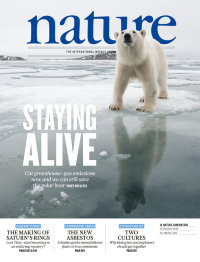Volume 468
-
No. 7326 16 December 2010
Polar bears live only in marine regions of the Northern Hemisphere where sea-ice cover persists for long enough to allow them sufficient opportunity to access their marine mammal prey. Recent declines in summer Arctic sea ice have coincided with declines in some polar bear populations, and a US Geological Survey report in 2007 projected that with business as usual emissions, polar bears could be extinct throughout their range by the end of the century. Some observers have suggested that summer Arctic sea ice might already have crossed a tipping point from beyond which habitats might not recover. But a new analysis suggests that it is not too late to save the polar bear. The rapid summer ice losses seen of late may represent increased volatility of a thinning sea-ice cover, rather than a tipping point. Greenhouse-gas mitigation could yet halt sea-ice loss and preserve the Arctic ecosystem. The cover shows a bear working its way through an area of marginal ice near the Svalbard Archipelago in the summer of 2009. Picture credit: Daniel J. Cox/NaturalExposures.com.
-
No. 7325 9 December 2010
The appearance of embryos in related species converges midway through development and diverges thereafter, a phenomenon known as the developmental hourglass. The hourglass model builds on classic observations by Karl Ernst von Baer, later popularized by Ernst Haeckel Charles Darwins champion in Germany. But is this phylotypic stage real? Two groups use contrasting methodology to test and provide support for the model. Genes expressed during the phylotypic stage are both evolutionarily older and more conserved across the genus than those expressed at other stages. On the cover, a version of Haeckels drawing of 1879 constructed from thousands of images of expression patterns during Drosophila embryogenesis. Picture credit: Pavel Tomancak
-
No. 7324 2 December 2010
Alphaviruses are significant animal and human pathogens - as demonstrated in recent outbreaks of infection with the mosquito-borne Chikungunya virus in India and southeast Asia. The E1 and E2 glycoproteins of alphaviruses are central to the way the virus infects host cells. The E1/E2 heterodimers that form spikes on the virus surface dissociate in the acidic conditions found in the internal vesicles of host cells, and E1 triggers infection by fusing with the endosomal membrane. Flix Rey and colleagues present the structure of Chikungunya virus envelope glycoprotein at neutral pH, and Michael Rossmann and colleagues reveal the structure of the envelope proteins of Sindbis virus at low pH. Sindbis virus can cause fever in humans and is the most extensively studied alphavirus. Comparison of the two structures provides insight into how fusion activation is controlled and points to possible vaccine targets. On the cover, surface structures of Chikungunya virus (right) and Sindbis virus.
-
No. 7323 25 November 2010
The physical linkage between the extracellular matrix and the actin cytoskeleton of a cell is made by focal adhesions, acting through integrin receptors. The molecular architecture of focal adhesions has now been determined using three-dimensional super-resolution fluorescence. They are revealed as well-organized ultrastructures in which integrins and actin are separated by a 40-nanometre-long core consisting of partially overlapping protein-specific layers, spanned by talin tethers. The multilaminar architecture creates three or more separate compartments that mediate the interdependent functions of focal adhesions. The cover shows a super-resolution fluorescence image of actin-mEos2 in U2OS osteosarcoma cells.
-
No. 7322 18 November 2010
The Icelandic volcano that produced the ash cloud that halted European air traffic last April had been active intermittently for about 18 years. A combination of space-based geodetic measurements and seismic monitoring of the EyjafjallajÖkull volcano in the run-up to the ash-producing explosion reveals unusual deformation patterns. The immediate short-term precursors to the initial eruption of the volcano in 2010 were subtle, but the clear signs of volcanic unrest during the weeks, months and years preceding the eruption may provide better clues as to the nature of the catastrophic explosion. The cover photo shows the base of the ash plume in the main crater on 11 May 2010, with hot bombs of lava being ejected hundreds of metres into the air. Credit: Fredrik Holm (www.fredrikholm.se)
-
No. 7321 11 November 2010
This special issue of Nature includes a series of News Features, Comment pieces and Perspectives on our current knowledge of schizophrenia and the research agenda. Advances in this area might help to control the condition in the next decades. The cover artwork is by Rodger Casier and NARSAD Artworks, a non-profit organization that showcases artists with mental illness. Proceeds from the art go to the research-funding body NARSAD.
Insight
-
No. 7320 4 November 2010
True three-dimensional holographic displays have so far lacked the capability of updating images with sufficient speed to convey movement. Now, a proof-of-principle experiment using a novel photorefractive polymeric material as the recording medium has produced a holographic display that refreshes every two seconds. Multicoloured and full parallax display are possible as is 3D telepresence, in which data describing holographic images can be transmitted from one location to another. The cover shows a photograph of a telepresence hologram recorded with the system (see Movie 2 in the papers Supplementary Information). A practical method of producing truly 3D images without the need for special eyewear would have many potential applications in telemedicine, mapping and entertainment, for instance.








